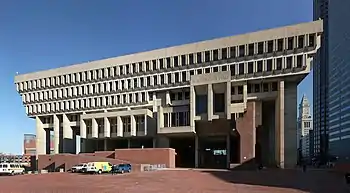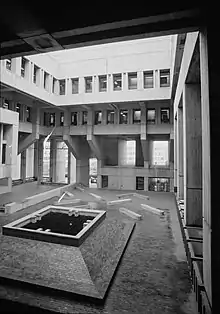Campbell, Aldrich & Nulty
Campbell, Aldrich & Nulty was a Boston, Massachusetts, United States, architectural firm. The firm's principals were forefront modernists, during the 1950s–1970s period when International Modernism matured in America. The successors to Campbell & Aldrich, the principals at Campbell, Aldrich & Nulty were Nelson Wilmarth Aldrich, who in the late 1930s studied under Walter Gropius and Marcel Breuer at the Harvard Graduate School of Design, and Lawrence Frederick Nulty.[1] In the late 1960s and in the 1970s, the partnership of Nelson Wilmarth Aldrich and Lawrence Frederick Nulty designed some of New England's most recognizable and controversial modernist architecture.

Building designs


Some of the New England structures designed by Campbell, Aldrich & Nulty in a modernist and frequently also brutalist architecture are Boston's 100 Federal Street[2] 37-floor skyscraper, which was formerly known as the First National Bank Building and is nicknamed the Pregnant Building; the Lederle Graduate Research Center at the University of Massachusetts Amherst; the Merrill Science Center at Amherst College; the Weiss Science Tower at Rockefeller University; the Murdough Center at New Hampshire's Dartmouth College;[3] and Boston City Hall.[4][5][6] A 1976 poll of architects, historians and critics conducted by the American Institute of Architects listed the Boston City Hall with Thomas Jefferson's University of Virginia campus and Frank Lloyd Wright's Fallingwater as one of the ten proudest achievements of American architecture in the nation's first two hundred years.[7]
Restorations
Campbell, Aldrich & Nulty also completed renovations of some of Massachusetts' best known historical buildings, including modern annexes for some. Notable among these renovations and additions are those at Trinity Church (Boston), the only church in the United States and the only building in Boston considered by the American Institute of Architects to be one of the "Ten Most Significant Buildings in the United States"; Emmanuel Episcopal Church, Boston; and Salem, Massachusetts' John Tucker Daland House.[8]
Nelson Wilmarth Aldrich
Campbell, Aldrich & Nulty's Nelson Wilmarth Aldrich (1911 – 1986) was not only an American modernist architect, but also a proponent of correlating theories of urbanism and urban planning. A nationally recognized social scientist, he was elected a fellow of the American Academy of Arts and Sciences in 1964.[9] A Boston civic leader, in the 1960s Nelson Wilmarth Aldrich was appointed a distinguished member of that city's Urban Renewal Design Advisory Committee with note that he was a principal at Campbell, Aldrich & Nulty.[10] He was a trustee of the Institute of Contemporary Art, Boston (1947-1960), the Boston Arts Festival (1955–62), the Metropolitan Boston Arts Center (1959-1963), the Rhode Island School of Design (1955-1962), Radcliffe College (1957-1972), and the Boston Architectural Center (1968-1973). Aldrich received his architecture degrees from Harvard University. Nelson Wilmarth Aldrich was the cousin of U.S. Vice President Nelson Aldrich Rockefeller and the nephew of Abby Aldrich Rockefeller, the daughter of the U.S. Senator Nelson Wilmarth Aldrich (1841-1915) and wife of John D. Rockefeller, Jr.
Further reading
References
- Ed. John F. Gane American Architects Directory, 3rd Edition, New York, New York: R.R. Bowker, LLC for American Institute of Architects © 1970, p. 133 ISBN 0-8352-0281-X
- Douglass Shand-Tucci Built in Boston: City and Suburb, 1800-2000 Univ. of Mass. Press (1999) ISBN 1-55849-201-1, ISBN 978-1-55849-201-1, p. 296, "By the late 1970s, however, it was not only at the head of State Street that the early efforts at a distinctive Modernist aesthetic sensitive to the historic city was being abandoned. In 1971 even so venerable an institution as the First National Bank of Boston was responsible for an astonishingly bombastic tower by Campbell, Aldrich and Nulty, the heavy, dark red granite bulging middle range of which is difficult to explain and impossible to defend."
- Scott Meacham, Dartmouth College: The Campus Guide, Princeton Architectural Press, 1st Edition (June 2008) ISBN 1-56898-348-4, p. 164 "61. The Murdough Center Campbell, Aldrich & Nulty, 1971-1973"
- Archived guided tour pamphlet for Boston City Hall, published by Boston City Council.
- Docomo U.S., international commission for the documentation and conservation of buildings, sites and neighborhoods of the modern movement, documentation of modern movement structures by designer
- "Archived copy". Archived from the original on 2013-12-17. Retrieved 2013-12-17.CS1 maint: archived copy as title (link) Synopsis of AIA Polls
- Bryant F. Tolles, Jr. Architecture of Salem UPNE (2004) ISBN 1-58465-385-X, p. 5 "Then from 1966-1968, based on plans of Campbell, Aldrich & Nulty, architects of Boston, …"
- Members of the American Academy of Arts and Sciences: 1780-2013, p. 8
- Philip Sinclair Hill Design Review in Urban Renewal: a Case Study of the Boston Redevelopment Authority (1966) (thesis housed at the Massachusetts Institute of Technology libraries) p. 38
